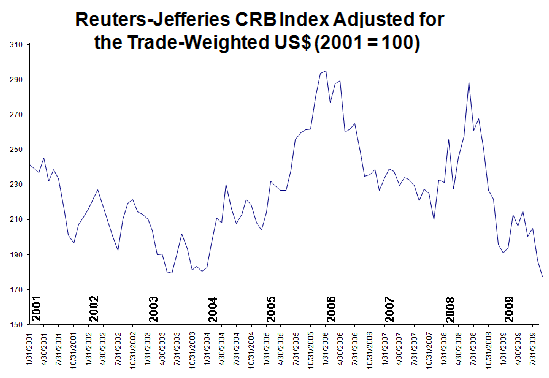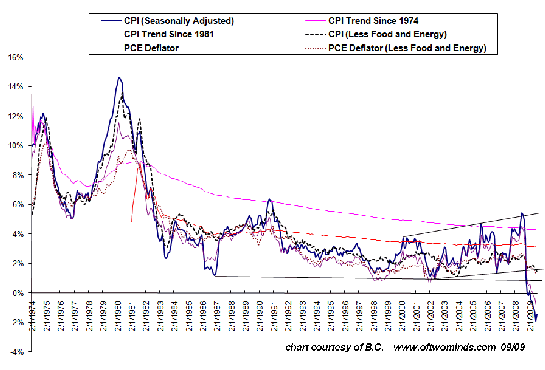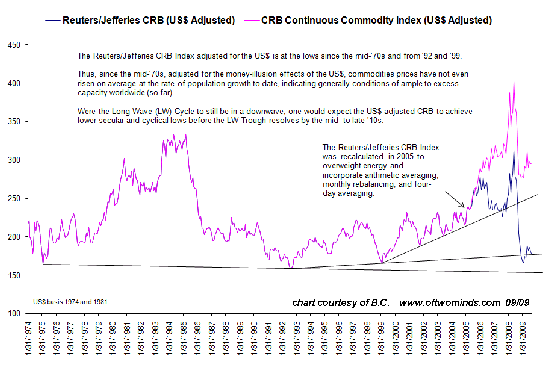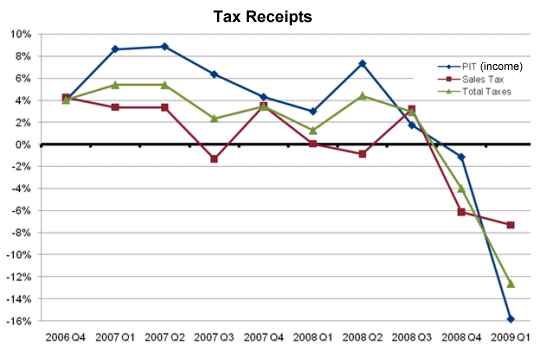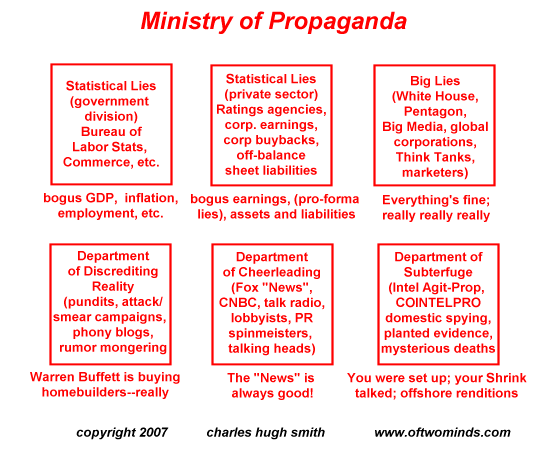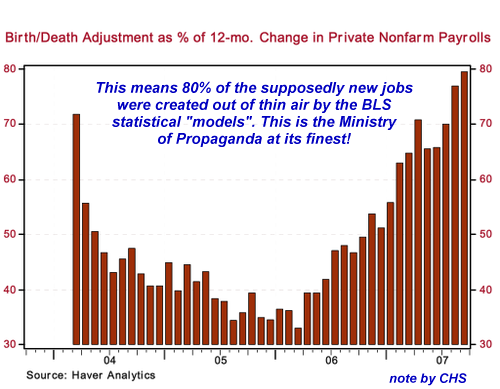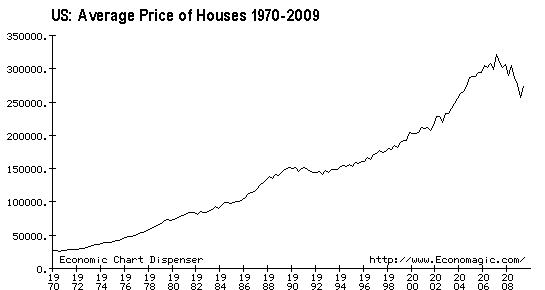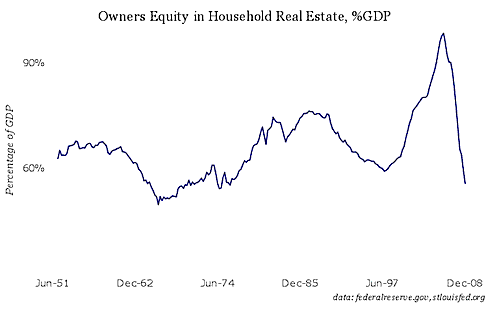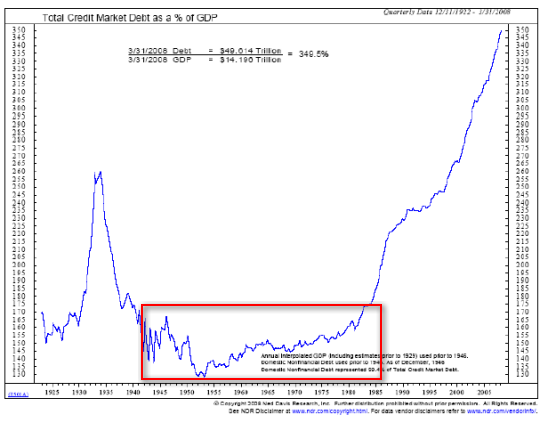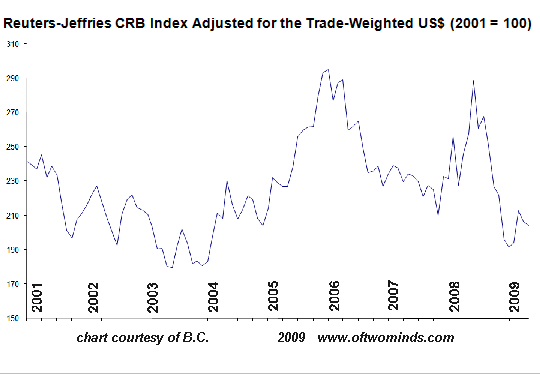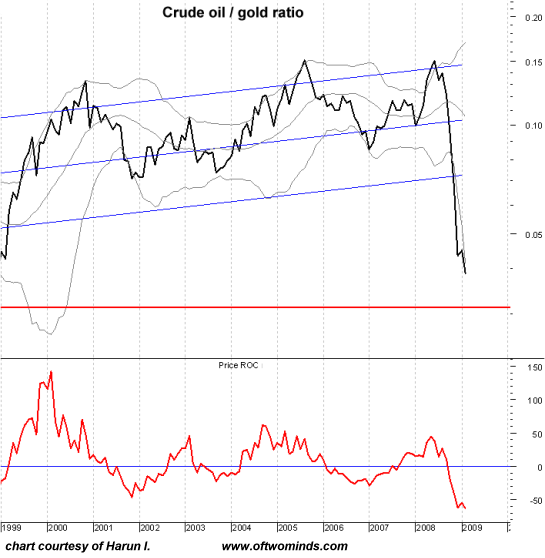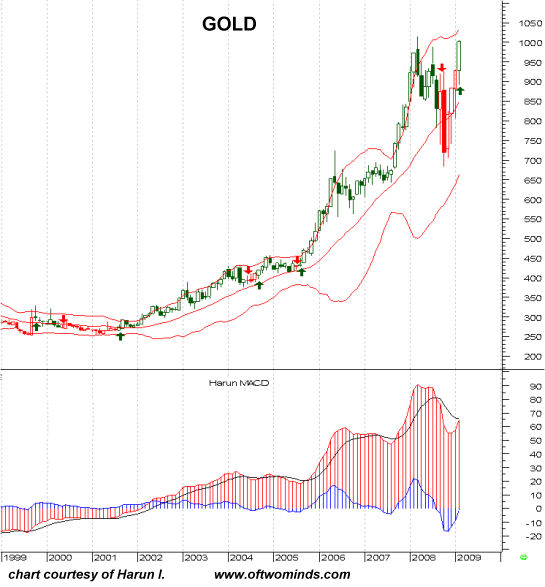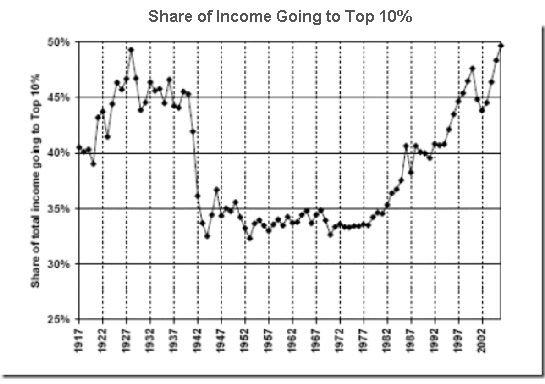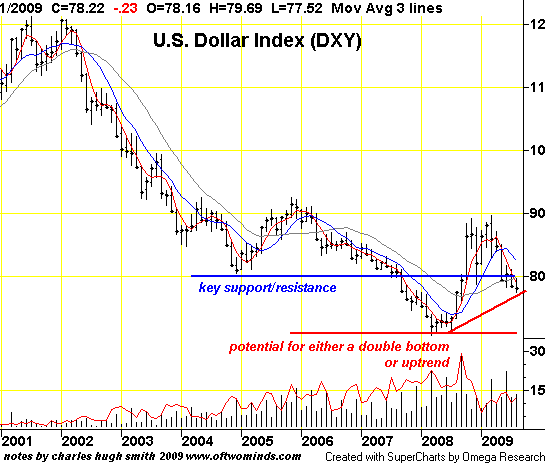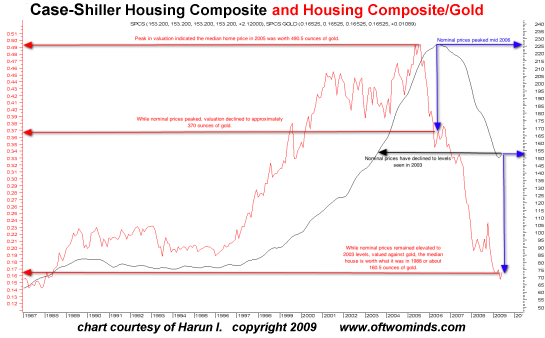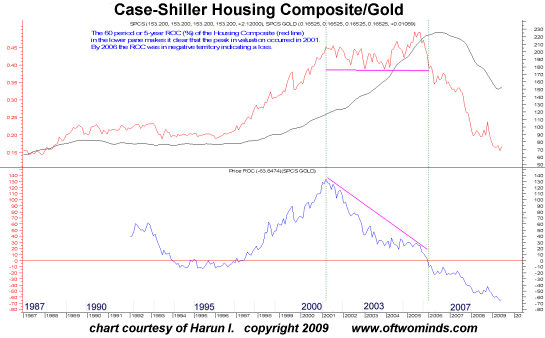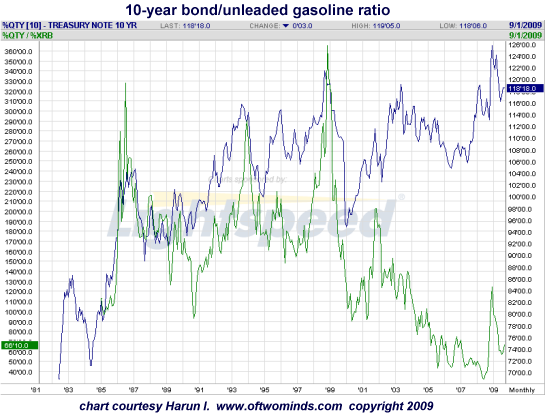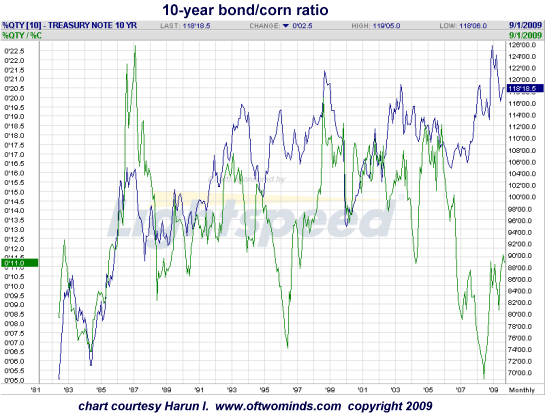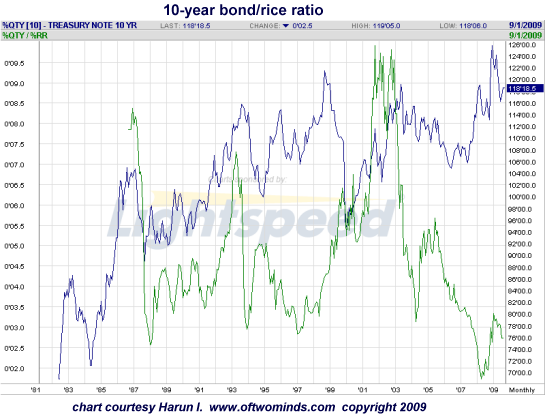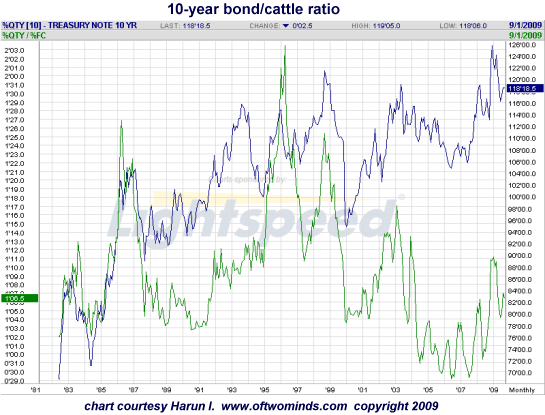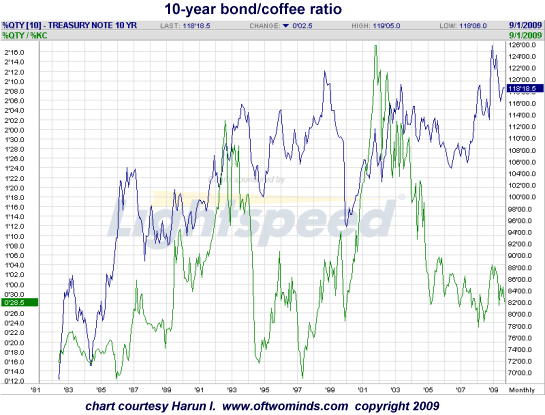When Honesty Becomes "Threatening"
Do we as a nation now fear the truth so much that we prefer deception and lies? Correspondent Harun I. recently wrote about the necessity in a democracy for an open and honest discussion of the sacrifices and trade-offs which must be made. I found his comments deeply disturbing because they clarified my sense that our government's policies are fundamentally based on the opposite of open honesty. Virtually every policy with any fiscal or financial consequence is shrouded in lies, deception, obfuscation, disinformation and propaganda. Yes, there is outrage in some quarters, and this is a positive sign. Even more positive is the growing demands for transparency and an honest accounting of our government's (and the Federal Reserve's) backstops, guarantees, actions and obligations. Yet I also sense a great fear of honesty, as if we don't really want to know how bad it is. On one level, this is understandable. Many of us sense something is terribly wrong, but like people who sense they might have cancer, we don't go to the doctor to receive the diagnosis: we react with denial and magical thinking, thus dooming our chances of recovery. (I've had melanoma, so I'm sympathetic to this feeling.) I see plentiful evidence that honesty is extremely threatening to the status quo. The Federal Reserve is in a full-blown panic that its machinations might be revealed to the public it claims to "serve." Here in California, a newspaper had to go to court and sue the local governments to release the salaries and total compensation of public union employees. Why would the unions and their employers be so terrified of transparency, of actually allowing the taxpayers who pay their salaries a glimpse of where their money is going? We all know the answer: because the public would be outraged to see the $200K salaries and double-dipping, the fat "consultant fees" paid the day after the employee retired, and on and on and on. The Fed is terrified of transparency for the exact same reason: that the citizenry will be outraged by the squandering of trillions of dollars, the machinations to protect the wealthy few at the expense of the many, and perhaps most damning of all, the utter failure of the Fed's manipulations, prevarications and obfuscations. The average American does not want to hear the "diagnosis" that Medicare and Medicaid are doomed to insolvency in a few short years, as is their entire government. They prefer soothing lies that nothing need be done except borrow another $2 trillion a year from now until Doomsday, which is but a few short years away. The truth is that Medicare is doomed and we shall not get the lavish care "promised" by our government. What year this becomes apparent I cannot say; it might be 2012, 2014 or 2019. Regardless, that year will come, and sooner than most think possible. The great sad irony is the fearful patient who refuses to even go to the doctor expires not from the cancer but from their unwillingness to get the truth early on and have an open, honest discussion about treatment options. I am saddened by the prospect that this describes our nation at a fundamental level. For it is insecurity and a total lack of confidence and faith that drives people to choose denial and magical thinking over truth, honesty and an open dialog. If one is confident that one can restore one's health, then the diagnosis, no matter how terrible, is welcomed so the treatment can begin immediately. Thus the current preference for lies, deception, propaganda, magical thinking and denial is deeply troubling, for it suggests America has lost its faith and confidence that it can solve its pressing financial/fiscal problems. I preface Harun's comments by noting that he served his country at the tip of the spear (U.S. Armed Forces) for many many years, serving in harm's way at the behest of this nation's civilian leadership, deploying in some of the most sensitive circumstances with some of the nation's most advanced technologies. Thus his words carry great weight, at least to me. Here is Harun's commentary: A right is defined as a moral or legal obligation. Quaint. I read comments posted on a blog that everyone has a "right" to the basics and that we should work to establish a "Star Trek" world. Well to all the socialists out there I offer that Nature did not get that memo. Nature mocks "rights" with famine, plague, pestilence and floods, and all such natural events harmful to our existence. It mocks "rights" by giving us limited resources. Katrina showed us vividly what happens to "rights" when resources are scarce and survival is threatened. Socialists even mock rights. If I own myself then it would follow that my labor and the fruit of it is my own property. But they would insist that others have a moral and legal obligation to my property (fruits of my labor) and therefore to me. Without consent, I would say that this defines the term slave. While it may be immoral to watch someone starve when it can be prevented it is equally immoral to enslave someone (deprive them of their freedom) to prevent it. That Obama wants to raise taxes on the wealthy because "they can afford it" is not the point. The point is freedom. The canon of this country holds that my body and mind belong to me and not the state. Since the labor (expenditure of energy physically or intellectually) of an individual and its fruits cannot be separated, socialism creates a state of slavery. Whether this arrangement is acceptable to a society is another matter but according to the body of law for our country, it is not freedom. If words are to have meaning and through logic convey truth then we must follow in the footsteps of Socrates and Plato and take the journey that leads to truth, however unpleasant. We must look at our words as we use them to define our beliefs. This is not about good and bad. If the truth is a thing we can all agree on (sure, I will work twice as hard to give up part of my pay to help a struggling family) then great. It is when we are not in agreement and graft and deception are used under the guise of law that problems arise. In South America there is a tribe that has an interesting concept. They are hunters. If you are successful, no problem. If you are unsuccessful either you starve or a successful hunter provides for your family. In doing so he gets to share in everything you have -- even your wife. Some would think this barbaric, I think it is one heck of an incentive to be a successful hunter! Regardless, it is unambiguous and agreed upon in that society. Traders I know are some of the greatest philanthropists, giving away millions every year to charities on top of paying taxes. A couple of my friends do not deduct these contributions on their taxes. No one forces them. That is freedom. There is no perfect society. Solving the problems of poverty in an industrial or post-industrial society is no trivial matter. What does one do when there is no work to be had and no land readily available upon which a man can grow his own food and livestock to provide for the basics for himself and his family? I do not have that answer but I do know that we should have an open and honest discussion and come to an agreement (what assistance will be given and how it will be funded). (Emphasis added: CHS) Dissembling and stealing, running up debts that can never be repaid and enslaving under the guise of law and sending the country lurching toward economic ruin are exactly what we should not do. We are entering an age where we will have to deal with facts instead of ignoring them. We can no longer afford to exist and function at low psychological levels associated with limbic responses. We can no longer afford a government that believes lies are necessary to maintain order. (Emphasis added: CHS) In the times to come we must know that it is in our best interest to do what is right and just despite our fear. And if one does not know what that means, go talk to a Vet whose buddy threw himself on a grenade to save his friends. Thank you, Harun. What we know about our government's responses to this entirely predictable financial meltdown is that truth and honesty are nowhere in sight. The government's top financial officers lied to Congress that the nation would implode if they didn't give extraordinary powers and extraordinary sums of money to Treasury officials working behind cloaks of secrecy and deception. A year later, the deceits, disinformation, half-truths, statistical conjuring and behind-the-scenes manipulations continue apace, with catastrophic results. The Treasury sells debt to the Fed which buys the debt with money created out of thin air, and we are told there is great demand for our new debt. Yes, the world is delighted to lend us $2 trillion a year, or perhaps it will be $3 trillion soon, or perhaps $10 trillion. There is no limit on the largesse--or on the lies. "Your book is truly a revolutionary act." Kenneth R. Thank you, Justin L. ($15), for your much-appreciated generous donation from Oz to this site. I am greatly honored by your support and readership.Civilization is a tenuous social arrangement at best. People bandy about the word "rights" as if it is some universal principle like physics. Any warrior would tell you that, outside of civilization, one only has a right to what he is strong enough to take and hold.
Permanent link: When Honesty Becomes "Threatening"
I've been invited to join the writers contributing to Seeking Alpha. You can also find my work on AOL's Daily Finance.
If you want more troubling/revolutionary/annoying analysis, please read Free eBook now available: HTML version: Survival+: Structuring Prosperity for Yourself and the Nation (PDF version (111 pages): Survival+)
Of Two Minds is now available via Kindle: Of Two Minds blog-Kindle





















